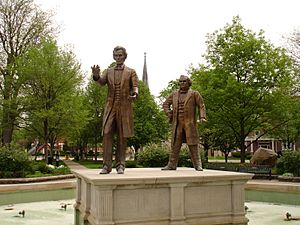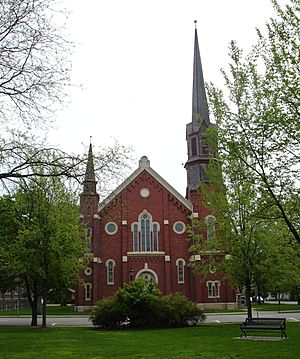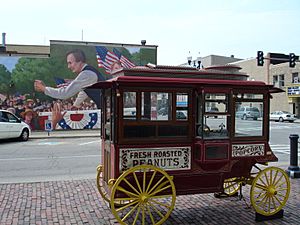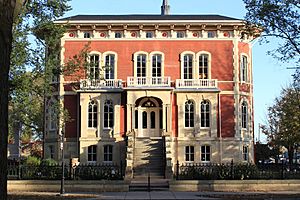Washington Park Historic District (Ottawa, Illinois) facts for kids
Quick facts for kids |
|
|
Washington Park Historic District
|
|
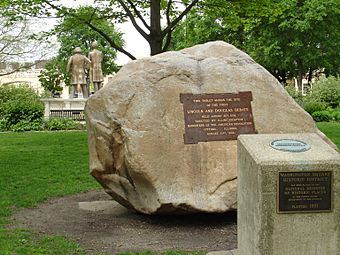
The site of the first Lincoln-Douglas debate in Washington Park
|
|
| Location | Bounded by Jackson, LaSalle, Lafayette, and Columbus Sts., Ottawa, Illinois |
|---|---|
| Area | 12.8 acres (5.2 ha) |
| Architectural style | Gothic Revival, Classical Revival, Italianate |
| NRHP reference No. | 73000710 |
| Added to NRHP | April 11, 1973 |
The Washington Park Historic District, also called Washington Square, is a special area in Ottawa, Illinois, Illinois. It's famous because the first Lincoln-Douglas debate happened here in 1858. This park is surrounded by many old and important buildings. The park was first planned in 1831. The entire historic district was added to the United States National Register of Historic Places in 1973.
Contents
Exploring Washington Park's Boundaries
The Washington Park Historic District covers the area around Washington Park, also known as Washington Square. On its north side, you'll find Lafayette Street. Jackson Street forms the southern edge. To the east is Columbus Street, and LaSalle Street is on the west.
This historic district includes seven important buildings. These are called "contributing properties" because they help tell the story of the area. There used to be eight, but one was taken down.
A Look Back at Washington Park's History
Washington Park was first planned in 1831. It was created by the Illinois and Michigan Canal Commission. This happened when the "states addition" of Ottawa was designed. It was a key part of the city's original layout.
The park became famous as the place of the first Lincoln-Douglas debate in 1858. It has also been used for many other community events over the years. In 1973, the park and its surrounding area were named a historic district. Many buildings here also have special local landmark status. In 2002, new statues of Lincoln and Douglas were added to the park.
Discover Washington Park Today
Washington Park takes up one whole city block next to downtown Ottawa. It's surrounded by several important old buildings. Inside the park, you can see many interesting things. There's an 1873 Civil War Memorial and cannons from the Civil War, World War I, and World War II. A special marker shows where the first Lincoln-Douglas debate took place.
In the middle of the park, there's a large patio with a fountain and a reflecting pool. In the center of the pool are large statues of Abraham Lincoln and Stephen A. Douglas. The statues stand on a plaza made of limestone. Artist Rebecca Childers Caleel created these bronze statues. They were put in place on September 14, 2002. The Lincoln statue is 11 feet (3.4 m) tall, and the Douglas statue is 9 feet (2.7 m) tall. Because they are newer, these statues are not part of the original historic district.
The park is very popular, especially during holidays. It has been a central part of Ottawa's community life since the 1850s. Besides its historical features, the park also has green spaces, benches, lights, and walkways. You'll see neat lawns, shade trees, evergreens, and tea roses.
Historic Buildings and Monuments
The 3rd Appellate Court Building
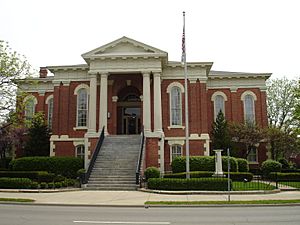
The Third District Appellate Court Building is on the northeast corner of Washington Square. It was built between 1857 and 1860. For ten years, it served as one of the Illinois Supreme Court buildings. In 1897, the state supreme courts in Ottawa, Mt. Vernon, and Springfield all moved to one location in Springfield. The court in Ottawa helped bring the Lincoln-Douglas Debate to the city. Today, the building at 1004 Columbus Street is still the Third District Appellate Court of Illinois.
This court building is a great example of Classical Revival architecture. It has large Doric columns and a big pediment (the triangular part above the columns). The main part of the building was built first, costing about US$230,000. The sides of the building were added in 1877. It's made of red brick with details from Joliet limestone. These features give the building a beautiful, balanced look. Many people in Ottawa think it's one of the city's most beautiful public buildings.
Civil War Memorial in the Park
The Civil War Memorial in Washington Park is a marble column built in 1873. Edward McInnhill designed and built it. The monument and the statue on top, called the Goddess of Liberty, honor LaSalle County veterans of the American Civil War. The marble has the names of over 800 soldiers who died in the war. However, many names are hard to read now because of age.
First Congregational Church
The Ottawa First Congregational Church was built in 1870. It stands near Jackson and Columbus Streets, facing Washington Park. The building is made of brick and designed in the Gothic Revival style.
Christ Episcopal Church
Christ Episcopal Church is another beautiful church on Washington Square. It's at the corner of Lafayette and Columbus Streets, across from the Appellate Courthouse. The church was built in 1871. It was for the first Episcopalian group in Ottawa, which started holding services in 1838. Architect A.H. Ellwood designed the church in the Gothic Revival style, common during the English Victorian era. Inside, there's a special "Wallace Window" showing the Resurrection. It was designed by German artist Julius Hübner.
Site of the Lincoln-Douglas Debate
On August 21, 1858, the first of the famous Lincoln-Douglas debates took place in Ottawa's Washington Park. A large boulder with a plaque marks the exact spot. The Daughters of the American Revolution put the boulder there on August 21, 1908. On the day of the debate, 10,000 people came to Washington Square. Salesmen sold their goods, and excited politicians talked and argued throughout the park.
Historic Popcorn Wagon
On the southwest corner of Washington Park, you can see a working popcorn wagon from the 1890s. It looks much like it did back then!
The William Reddick Mansion
The Reddick Mansion, also known as Reddick's Library, was built around 1856. It was built by William Reddick, who was the sheriff at the time. The building is across from the Third Appellate Court and cost $40,000 to build. Reddick later served in the Illinois State Senate. When he left office, he returned to live in this house in Ottawa. He was known as a colorful and kind person in Ottawa. It is said that Reddick helped runaway slaves by housing them in his mansion. This made his home a "station" on the Underground Railroad. He lived in the mansion until he passed away in 1885.
In his will, Reddick said that his mansion should become a public library after he died. He also left $100,000 to help make this happen. The public library opened in the Reddick Mansion in 1888. It served the city of Ottawa until 1974. That year, the library moved to a new building. The Reddick Mansion Association was then formed to restore and take care of the house. Today, the Reddick Mansion is open for public tours.
The Reddick Mansion is a beautiful example of the Italianate architectural style. The architectural firm Olmsted & Nicholson designed it. Look closely at the brick and stone work, and the wood details under the cornice and eaves. These parts are especially interesting.
Other Places of Interest
Within the historic district boundaries, some properties that were once part of the district have been taken down. The LaSalle County Jail building was there when the district was first named, but it has since been demolished. The jail used to be a single-family home from around 1880. It was important for its architecture and its connection to local politics. Inside Washington Park, there were also original 1857 gas lamps. They were arranged in a circle to honor W.D. Boyce, who was from Ottawa and founded the Boy Scouts of America. These lamps were located where the reflecting pool is now.
There are also buildings that are not considered part of the historic district. These are called "non-contributing properties." Before the 1980s, most U.S. historic districts didn't track these non-contributing buildings. But today, the Illinois Historic Preservation Agency's database does. For example, the 1910 Masonic Temple building is a non-contributing property. It's on Columbus Street, between the two historic churches.
Why Washington Park is So Important
Washington Square is very important because it hosted the first of the famous Lincoln-Douglas Debates. These debates lasted three hours under the hot August sun. They focused on big issues like popular sovereignty (the idea that people should decide for themselves) and slavery. These topics set the stage for the other debates that followed in 1858.
Because of its historical importance as the site of the first Lincoln-Douglas debate, and the good condition of its historic buildings, the Washington Park Historic District was added to the U.S. National Register of Historic Places on April 11, 1973.
- National Historic Landmarks Program, "Search for an NHL", City and state query=Ottawa, Illinois, National Park Service, accessed May 12, 2008.
- Fetzer, Constance. "Popcorn Stand" (PDF), Illinois Historic Sites Survey Inventory Form, 1972, Illinois Historic Preservation Agency, accessed May 12, 2008.
- Fetzer, Constance. "Washington Park", (PDF), Illinois Historic Sites Survey Inventory Form, 1972, Illinois Historic Preservation Agency, accessed May 12, 2008."
- Abraham Lincoln and Stephen A. Douglas. "First Debate with Stephen A. Douglas at Ottawa, Illinois", August 21, 1858, Lincoln Home National Historic Site, National Park Service, accessed May 12, 2008.




